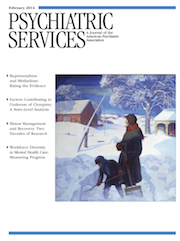To the Editor: I read the article about racial-ethnic differences in the prevalence of psychotic symptoms (
1) in the November 2013 issue with great interest. Although the primary finding of a relationship between psychosis and distress across racial-ethnic groups is of value, methodological concerns limit the utility of the Collaborative Psychiatric Epidemiology Surveys (CPES) data set in assessing racial-ethnic differences in psychosis prevalence.
The central concern is related to the National Comorbidity Survey Replication (NCS-R), one of three component surveys of the CPES data set, along with the National Latino and Asian American Study (NLAAS) and the National Survey of American Life (NSAL). The psychosis screen was administered to all NLAAS respondents and all nonwhite NSAL respondents. However, it was administered only to a random subsample of the NCS-R (
2)—of the 5,692 long-form respondents, only 2,322 received the psychosis screen.
This creates two difficulties. First, because the CPES data are weighted under the assumption that the researcher is using the entire data set, this has the effect of drastically underweighting the NCS-R respondents who responded to the psychosis screen. The second issue arises if the unscreened NCS-R respondents are treated as uniformly not having psychotic experiences. In this case, the weights are appropriate to make the sample nationally representative, but prevalence is underestimated because most NCS-R respondents (N=3,370) are automatically coded as not having psychotic experiences. This is especially problematic when prevalence rates across racial-ethnic groups are compared, which is unfortunate given the lack of reliable U.S. prevalence data on subthreshold psychosis by racial-ethnic group.
Both issues are present but overlooked in the November article. The lifetime prevalence estimates were based on the limited sample (unscreened NCS-R respondents were excluded; verified through independent analysis), and therefore the sample was not nationally representative. The 12-month prevalence estimates, on the other hand, utilized the entire sample. They were therefore properly weighted but are underestimates, because the large unscreened subsample was coded as not having psychotic symptoms. The authors note that the 12-month prevalence rates are low compared with prior studies, but they do not acknowledge this likely explanation.
Rerunning these analyses with the 3,370 NCS-R respondents with missing data excluded yields higher prevalence rates across ethnic groups, most notably among whites, the most numerous group in the NCS-R. The recalculated rate for whites is 2.1%, compared with .8% as reported in the November article. For Latinos, it is 3.3%, compared with 2.9%; and for blacks, it is 4.4%, compared with 3.8%). Only the Asian group is unaffected, due to limited Asian representation. The lifetime prevalence rates reported in the November article also appear to include psychotic experiences that occur in the context of falling asleep, dreaming, or substance use, which were excluded from the 12-month item, further explaining the discrepancy between lifetime and 12-month estimates.
This does not negate the value of the study, particularly regarding its analysis of the relationship between psychotic symptoms and distress. However, these concerns should be taken into consideration when interpreting the prevalence of psychosis across racial-ethnic groups.

